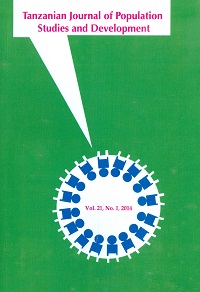The Environmental and Economical Challenges in Fishing Industry: The Case of Bagamoyo District
Abstract
Fishing is Bagamoyo ' s second biggest industry after agriculture. Artisanal fishing is dominant and engages numerous fishing vessels. However, artisanal fishing is mainly in the very shallow waters while trawlers, mostly foreign owned, fish in areas ranging from coast to more than 20m deep. The trawlers scoops all types and sizes of fish, and ultimately retain only those aspired for markets, while artisanal fisheries in their old, worn out dugout canoes resort to dynamite fishing and coral mining for quick production. In addition to normal nets, the seine nets which destroy much of species and coastal reefs are also in wide use due to economic hardships. These trends contribute towards the degradation of coral reef ecosystem and pose as environmental challenges including loss of valuable natural habitat, reduction in biodiversity and marine lives. This paper discusses the state of affairs of artisanal fisher people that derive environmental and economical challenges in fishing industry, and looks at the actions necessary to save the industry from over-fishing and the juvenile fishing, and to protect the unique and fragile reefs.
References
Gibson, R., A. Persson, & M. Robertson. 2001. Bagamoyo Fishing Industry. A Report based on six week field Study in Bagamoyo.
Hardin, G. 1968. The Tragedy of the Commons. Science, 162: 1243 €“48.
Haule, V.M. (Undated). Reducing the Impact of Tropical Shrimp Trawling Fisheries on Living Marine Resources Through the Adoption of Environmentally Friendly Techniques and Practices in Tanzania.
Maghimbi, S. 2004, Land Tenure Reform as an Instrumental of Better Resource Use: A case Stady of Nomads in the Drylands of Northern and Central Tanzania. In H. Oyieke et al eds. (2004), Sustainable Biodiversity Management for Reduced Community Vulnerability to Drought. Nairobi: RPSUD.
Maghimbi, S., & G.M. Naimani. 1997. FAO Project Report on Representative Household Survey, Bagamoyo District, Tanzania.
Mgaya. Y.D., G.D. Msumi, M.H.S. Muruke, & A.K. Semesi. 1999. Assessment of Finfish Fishery in Bagamoyo Coastal Waters. In K.M. Howell and A.K. Semesi (eds). 1977.Proceedings of a Workshop on Coastal Resources of Bagamoyo.
Semesi, A.K., Y.D. Mgaya, M.H. Muruke, J. Francis, M. Mtolera, & G. Msumi. 1998. Coastal Resources Utilization and Conservation Issues in Bagamoyo, Tanzania. Ambio Vol. 27 No 8. Royal Swedish Academy of Science.
Sobo, F.A. 1999. Fisheries Management in Tanzania. In: K.M. Howell and A.K. Semesi (eds.). Proceedings of a Workshop on Coastal Resources of Bagamoyo.


